Post-Operative Care: A Case Study of a Patient with Uterine Fibroids
VerifiedAdded on 2023/06/07
|11
|2965
|89
AI Summary
This essay discusses a case study of a patient with uterine fibroids who underwent Total Abdominal Hysterectomy. It elaborates on the aetiology, pathophysiology, and care priorities of the patient during the post-operative period.
Contribute Materials
Your contribution can guide someone’s learning journey. Share your
documents today.

Running head: CASE STUDY
Nursing Assignment
Name of the Student
Name of the University
Author Note
Nursing Assignment
Name of the Student
Name of the University
Author Note
Secure Best Marks with AI Grader
Need help grading? Try our AI Grader for instant feedback on your assignments.
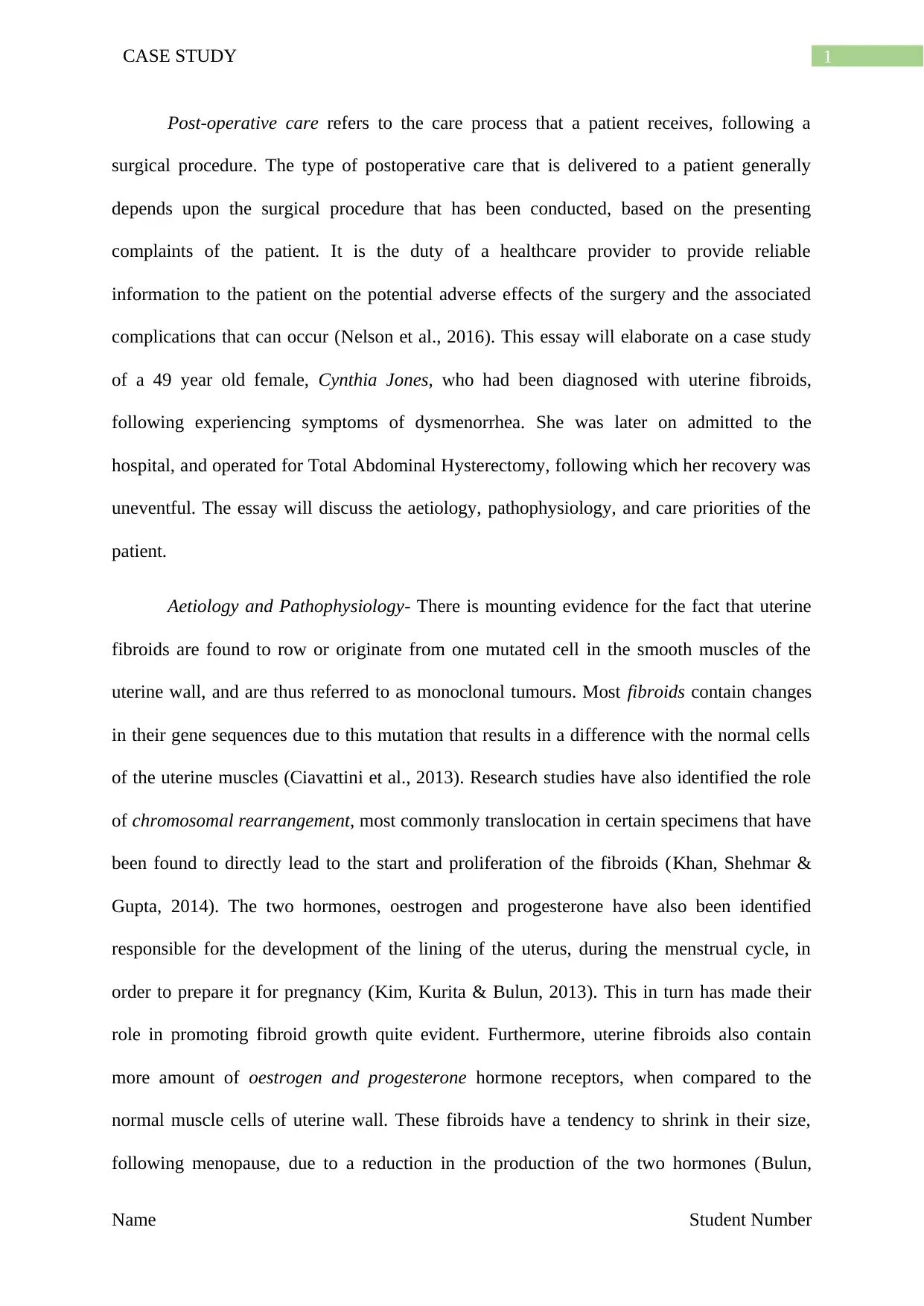
1CASE STUDY
Post-operative care refers to the care process that a patient receives, following a
surgical procedure. The type of postoperative care that is delivered to a patient generally
depends upon the surgical procedure that has been conducted, based on the presenting
complaints of the patient. It is the duty of a healthcare provider to provide reliable
information to the patient on the potential adverse effects of the surgery and the associated
complications that can occur (Nelson et al., 2016). This essay will elaborate on a case study
of a 49 year old female, Cynthia Jones, who had been diagnosed with uterine fibroids,
following experiencing symptoms of dysmenorrhea. She was later on admitted to the
hospital, and operated for Total Abdominal Hysterectomy, following which her recovery was
uneventful. The essay will discuss the aetiology, pathophysiology, and care priorities of the
patient.
Aetiology and Pathophysiology- There is mounting evidence for the fact that uterine
fibroids are found to row or originate from one mutated cell in the smooth muscles of the
uterine wall, and are thus referred to as monoclonal tumours. Most fibroids contain changes
in their gene sequences due to this mutation that results in a difference with the normal cells
of the uterine muscles (Ciavattini et al., 2013). Research studies have also identified the role
of chromosomal rearrangement, most commonly translocation in certain specimens that have
been found to directly lead to the start and proliferation of the fibroids (Khan, Shehmar &
Gupta, 2014). The two hormones, oestrogen and progesterone have also been identified
responsible for the development of the lining of the uterus, during the menstrual cycle, in
order to prepare it for pregnancy (Kim, Kurita & Bulun, 2013). This in turn has made their
role in promoting fibroid growth quite evident. Furthermore, uterine fibroids also contain
more amount of oestrogen and progesterone hormone receptors, when compared to the
normal muscle cells of uterine wall. These fibroids have a tendency to shrink in their size,
following menopause, due to a reduction in the production of the two hormones (Bulun,
Name Student Number
Post-operative care refers to the care process that a patient receives, following a
surgical procedure. The type of postoperative care that is delivered to a patient generally
depends upon the surgical procedure that has been conducted, based on the presenting
complaints of the patient. It is the duty of a healthcare provider to provide reliable
information to the patient on the potential adverse effects of the surgery and the associated
complications that can occur (Nelson et al., 2016). This essay will elaborate on a case study
of a 49 year old female, Cynthia Jones, who had been diagnosed with uterine fibroids,
following experiencing symptoms of dysmenorrhea. She was later on admitted to the
hospital, and operated for Total Abdominal Hysterectomy, following which her recovery was
uneventful. The essay will discuss the aetiology, pathophysiology, and care priorities of the
patient.
Aetiology and Pathophysiology- There is mounting evidence for the fact that uterine
fibroids are found to row or originate from one mutated cell in the smooth muscles of the
uterine wall, and are thus referred to as monoclonal tumours. Most fibroids contain changes
in their gene sequences due to this mutation that results in a difference with the normal cells
of the uterine muscles (Ciavattini et al., 2013). Research studies have also identified the role
of chromosomal rearrangement, most commonly translocation in certain specimens that have
been found to directly lead to the start and proliferation of the fibroids (Khan, Shehmar &
Gupta, 2014). The two hormones, oestrogen and progesterone have also been identified
responsible for the development of the lining of the uterus, during the menstrual cycle, in
order to prepare it for pregnancy (Kim, Kurita & Bulun, 2013). This in turn has made their
role in promoting fibroid growth quite evident. Furthermore, uterine fibroids also contain
more amount of oestrogen and progesterone hormone receptors, when compared to the
normal muscle cells of uterine wall. These fibroids have a tendency to shrink in their size,
following menopause, due to a reduction in the production of the two hormones (Bulun,
Name Student Number
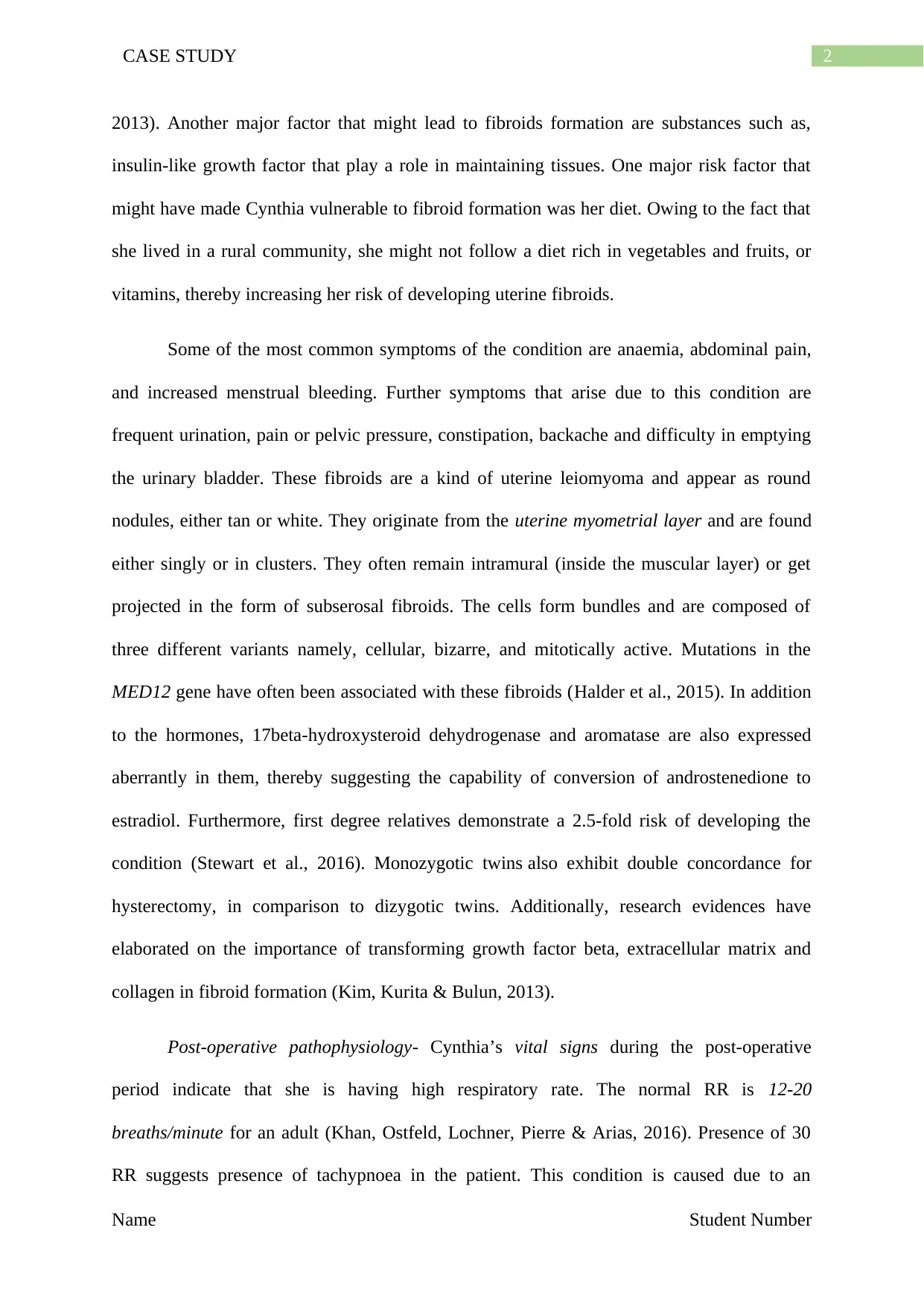
2CASE STUDY
2013). Another major factor that might lead to fibroids formation are substances such as,
insulin-like growth factor that play a role in maintaining tissues. One major risk factor that
might have made Cynthia vulnerable to fibroid formation was her diet. Owing to the fact that
she lived in a rural community, she might not follow a diet rich in vegetables and fruits, or
vitamins, thereby increasing her risk of developing uterine fibroids.
Some of the most common symptoms of the condition are anaemia, abdominal pain,
and increased menstrual bleeding. Further symptoms that arise due to this condition are
frequent urination, pain or pelvic pressure, constipation, backache and difficulty in emptying
the urinary bladder. These fibroids are a kind of uterine leiomyoma and appear as round
nodules, either tan or white. They originate from the uterine myometrial layer and are found
either singly or in clusters. They often remain intramural (inside the muscular layer) or get
projected in the form of subserosal fibroids. The cells form bundles and are composed of
three different variants namely, cellular, bizarre, and mitotically active. Mutations in the
MED12 gene have often been associated with these fibroids (Halder et al., 2015). In addition
to the hormones, 17beta-hydroxysteroid dehydrogenase and aromatase are also expressed
aberrantly in them, thereby suggesting the capability of conversion of androstenedione to
estradiol. Furthermore, first degree relatives demonstrate a 2.5-fold risk of developing the
condition (Stewart et al., 2016). Monozygotic twins also exhibit double concordance for
hysterectomy, in comparison to dizygotic twins. Additionally, research evidences have
elaborated on the importance of transforming growth factor beta, extracellular matrix and
collagen in fibroid formation (Kim, Kurita & Bulun, 2013).
Post-operative pathophysiology- Cynthia’s vital signs during the post-operative
period indicate that she is having high respiratory rate. The normal RR is 12-20
breaths/minute for an adult (Khan, Ostfeld, Lochner, Pierre & Arias, 2016). Presence of 30
RR suggests presence of tachypnoea in the patient. This condition is caused due to an
Name Student Number
2013). Another major factor that might lead to fibroids formation are substances such as,
insulin-like growth factor that play a role in maintaining tissues. One major risk factor that
might have made Cynthia vulnerable to fibroid formation was her diet. Owing to the fact that
she lived in a rural community, she might not follow a diet rich in vegetables and fruits, or
vitamins, thereby increasing her risk of developing uterine fibroids.
Some of the most common symptoms of the condition are anaemia, abdominal pain,
and increased menstrual bleeding. Further symptoms that arise due to this condition are
frequent urination, pain or pelvic pressure, constipation, backache and difficulty in emptying
the urinary bladder. These fibroids are a kind of uterine leiomyoma and appear as round
nodules, either tan or white. They originate from the uterine myometrial layer and are found
either singly or in clusters. They often remain intramural (inside the muscular layer) or get
projected in the form of subserosal fibroids. The cells form bundles and are composed of
three different variants namely, cellular, bizarre, and mitotically active. Mutations in the
MED12 gene have often been associated with these fibroids (Halder et al., 2015). In addition
to the hormones, 17beta-hydroxysteroid dehydrogenase and aromatase are also expressed
aberrantly in them, thereby suggesting the capability of conversion of androstenedione to
estradiol. Furthermore, first degree relatives demonstrate a 2.5-fold risk of developing the
condition (Stewart et al., 2016). Monozygotic twins also exhibit double concordance for
hysterectomy, in comparison to dizygotic twins. Additionally, research evidences have
elaborated on the importance of transforming growth factor beta, extracellular matrix and
collagen in fibroid formation (Kim, Kurita & Bulun, 2013).
Post-operative pathophysiology- Cynthia’s vital signs during the post-operative
period indicate that she is having high respiratory rate. The normal RR is 12-20
breaths/minute for an adult (Khan, Ostfeld, Lochner, Pierre & Arias, 2016). Presence of 30
RR suggests presence of tachypnoea in the patient. This condition is caused due to an
Name Student Number
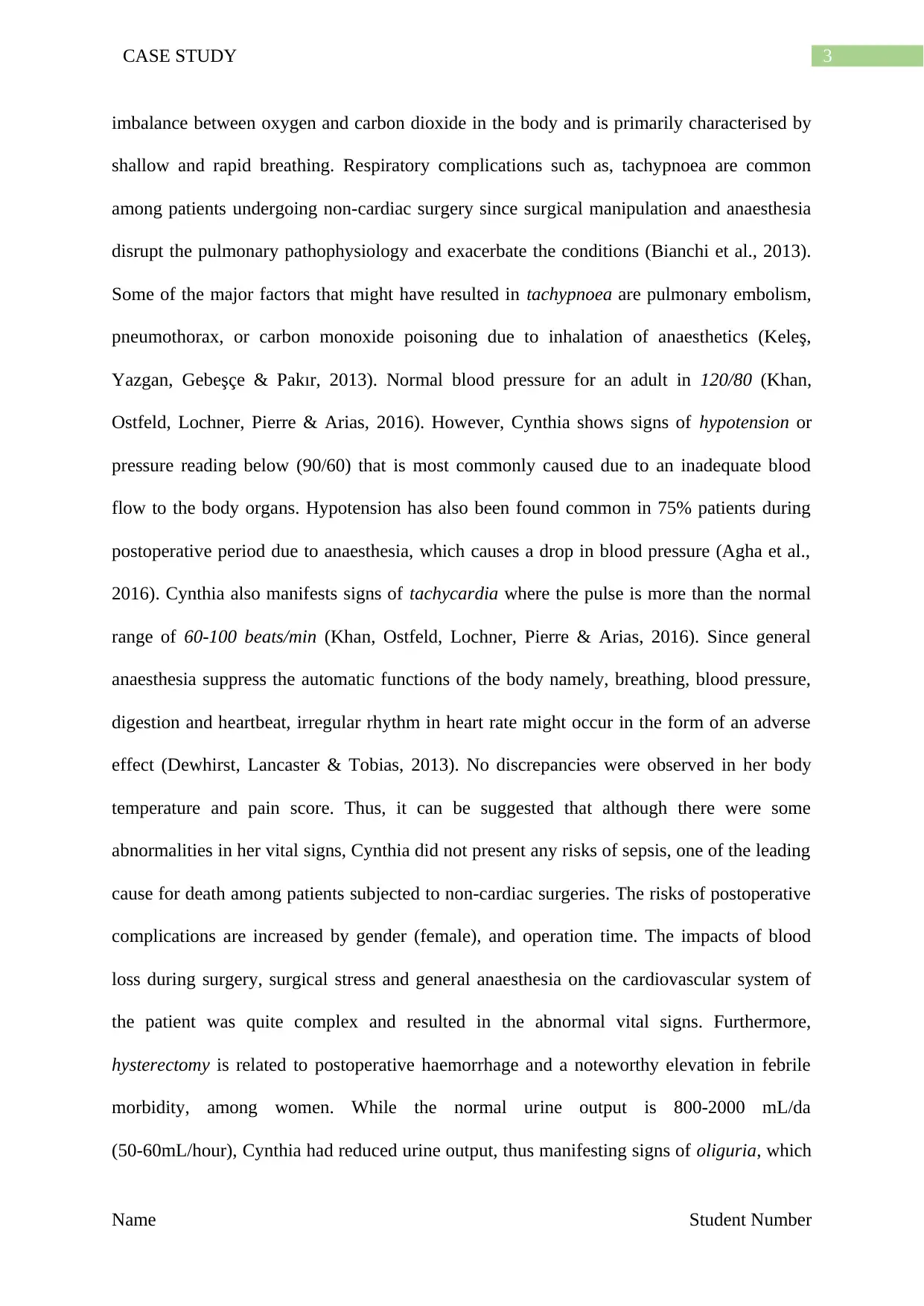
3CASE STUDY
imbalance between oxygen and carbon dioxide in the body and is primarily characterised by
shallow and rapid breathing. Respiratory complications such as, tachypnoea are common
among patients undergoing non-cardiac surgery since surgical manipulation and anaesthesia
disrupt the pulmonary pathophysiology and exacerbate the conditions (Bianchi et al., 2013).
Some of the major factors that might have resulted in tachypnoea are pulmonary embolism,
pneumothorax, or carbon monoxide poisoning due to inhalation of anaesthetics (Keleş,
Yazgan, Gebeşçe & Pakır, 2013). Normal blood pressure for an adult in 120/80 (Khan,
Ostfeld, Lochner, Pierre & Arias, 2016). However, Cynthia shows signs of hypotension or
pressure reading below (90/60) that is most commonly caused due to an inadequate blood
flow to the body organs. Hypotension has also been found common in 75% patients during
postoperative period due to anaesthesia, which causes a drop in blood pressure (Agha et al.,
2016). Cynthia also manifests signs of tachycardia where the pulse is more than the normal
range of 60-100 beats/min (Khan, Ostfeld, Lochner, Pierre & Arias, 2016). Since general
anaesthesia suppress the automatic functions of the body namely, breathing, blood pressure,
digestion and heartbeat, irregular rhythm in heart rate might occur in the form of an adverse
effect (Dewhirst, Lancaster & Tobias, 2013). No discrepancies were observed in her body
temperature and pain score. Thus, it can be suggested that although there were some
abnormalities in her vital signs, Cynthia did not present any risks of sepsis, one of the leading
cause for death among patients subjected to non-cardiac surgeries. The risks of postoperative
complications are increased by gender (female), and operation time. The impacts of blood
loss during surgery, surgical stress and general anaesthesia on the cardiovascular system of
the patient was quite complex and resulted in the abnormal vital signs. Furthermore,
hysterectomy is related to postoperative haemorrhage and a noteworthy elevation in febrile
morbidity, among women. While the normal urine output is 800-2000 mL/da
(50-60mL/hour), Cynthia had reduced urine output, thus manifesting signs of oliguria, which
Name Student Number
imbalance between oxygen and carbon dioxide in the body and is primarily characterised by
shallow and rapid breathing. Respiratory complications such as, tachypnoea are common
among patients undergoing non-cardiac surgery since surgical manipulation and anaesthesia
disrupt the pulmonary pathophysiology and exacerbate the conditions (Bianchi et al., 2013).
Some of the major factors that might have resulted in tachypnoea are pulmonary embolism,
pneumothorax, or carbon monoxide poisoning due to inhalation of anaesthetics (Keleş,
Yazgan, Gebeşçe & Pakır, 2013). Normal blood pressure for an adult in 120/80 (Khan,
Ostfeld, Lochner, Pierre & Arias, 2016). However, Cynthia shows signs of hypotension or
pressure reading below (90/60) that is most commonly caused due to an inadequate blood
flow to the body organs. Hypotension has also been found common in 75% patients during
postoperative period due to anaesthesia, which causes a drop in blood pressure (Agha et al.,
2016). Cynthia also manifests signs of tachycardia where the pulse is more than the normal
range of 60-100 beats/min (Khan, Ostfeld, Lochner, Pierre & Arias, 2016). Since general
anaesthesia suppress the automatic functions of the body namely, breathing, blood pressure,
digestion and heartbeat, irregular rhythm in heart rate might occur in the form of an adverse
effect (Dewhirst, Lancaster & Tobias, 2013). No discrepancies were observed in her body
temperature and pain score. Thus, it can be suggested that although there were some
abnormalities in her vital signs, Cynthia did not present any risks of sepsis, one of the leading
cause for death among patients subjected to non-cardiac surgeries. The risks of postoperative
complications are increased by gender (female), and operation time. The impacts of blood
loss during surgery, surgical stress and general anaesthesia on the cardiovascular system of
the patient was quite complex and resulted in the abnormal vital signs. Furthermore,
hysterectomy is related to postoperative haemorrhage and a noteworthy elevation in febrile
morbidity, among women. While the normal urine output is 800-2000 mL/da
(50-60mL/hour), Cynthia had reduced urine output, thus manifesting signs of oliguria, which
Name Student Number
Secure Best Marks with AI Grader
Need help grading? Try our AI Grader for instant feedback on your assignments.
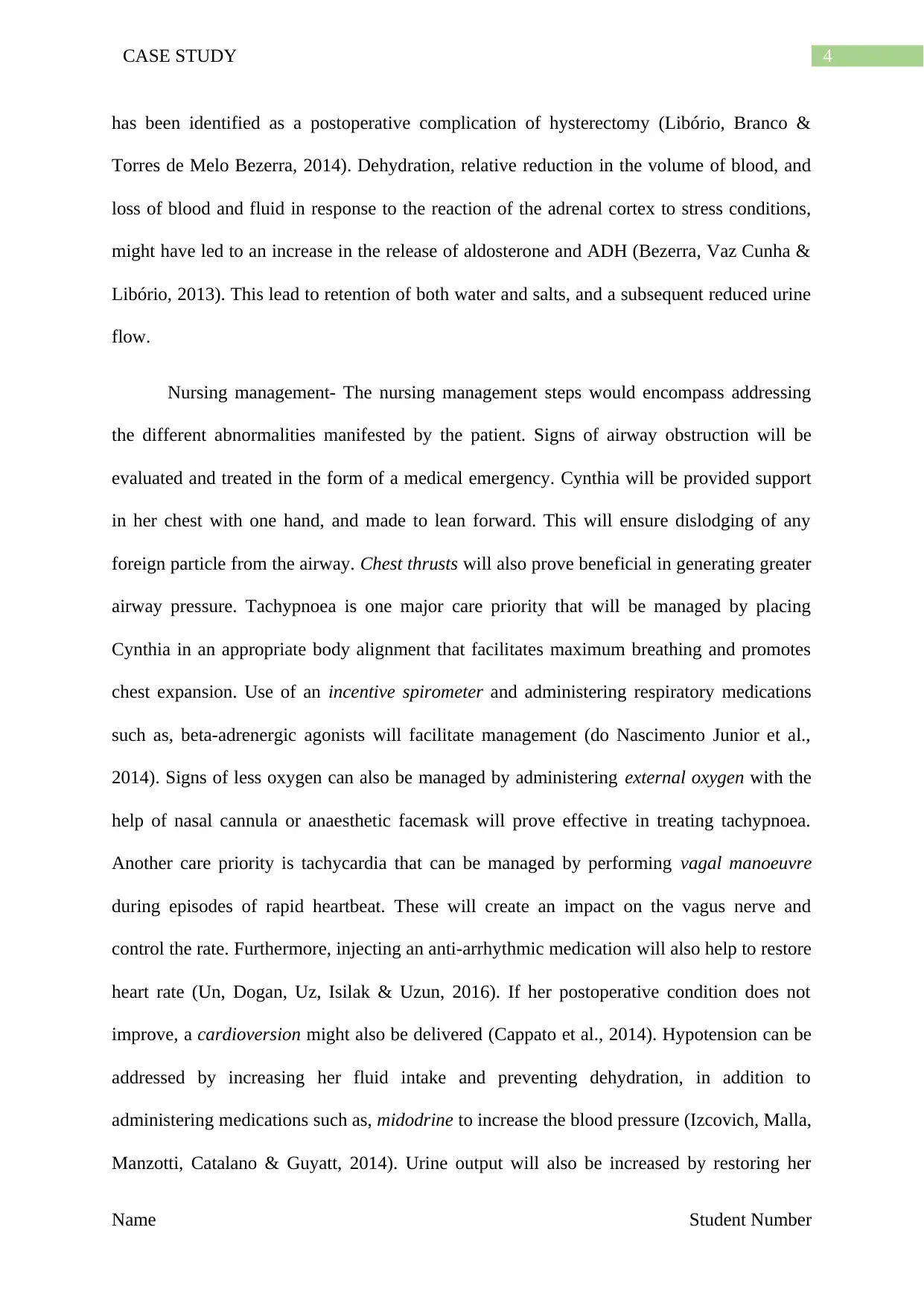
4CASE STUDY
has been identified as a postoperative complication of hysterectomy (Libório, Branco &
Torres de Melo Bezerra, 2014). Dehydration, relative reduction in the volume of blood, and
loss of blood and fluid in response to the reaction of the adrenal cortex to stress conditions,
might have led to an increase in the release of aldosterone and ADH (Bezerra, Vaz Cunha &
Libório, 2013). This lead to retention of both water and salts, and a subsequent reduced urine
flow.
Nursing management- The nursing management steps would encompass addressing
the different abnormalities manifested by the patient. Signs of airway obstruction will be
evaluated and treated in the form of a medical emergency. Cynthia will be provided support
in her chest with one hand, and made to lean forward. This will ensure dislodging of any
foreign particle from the airway. Chest thrusts will also prove beneficial in generating greater
airway pressure. Tachypnoea is one major care priority that will be managed by placing
Cynthia in an appropriate body alignment that facilitates maximum breathing and promotes
chest expansion. Use of an incentive spirometer and administering respiratory medications
such as, beta-adrenergic agonists will facilitate management (do Nascimento Junior et al.,
2014). Signs of less oxygen can also be managed by administering external oxygen with the
help of nasal cannula or anaesthetic facemask will prove effective in treating tachypnoea.
Another care priority is tachycardia that can be managed by performing vagal manoeuvre
during episodes of rapid heartbeat. These will create an impact on the vagus nerve and
control the rate. Furthermore, injecting an anti-arrhythmic medication will also help to restore
heart rate (Un, Dogan, Uz, Isilak & Uzun, 2016). If her postoperative condition does not
improve, a cardioversion might also be delivered (Cappato et al., 2014). Hypotension can be
addressed by increasing her fluid intake and preventing dehydration, in addition to
administering medications such as, midodrine to increase the blood pressure (Izcovich, Malla,
Manzotti, Catalano & Guyatt, 2014). Urine output will also be increased by restoring her
Name Student Number
has been identified as a postoperative complication of hysterectomy (Libório, Branco &
Torres de Melo Bezerra, 2014). Dehydration, relative reduction in the volume of blood, and
loss of blood and fluid in response to the reaction of the adrenal cortex to stress conditions,
might have led to an increase in the release of aldosterone and ADH (Bezerra, Vaz Cunha &
Libório, 2013). This lead to retention of both water and salts, and a subsequent reduced urine
flow.
Nursing management- The nursing management steps would encompass addressing
the different abnormalities manifested by the patient. Signs of airway obstruction will be
evaluated and treated in the form of a medical emergency. Cynthia will be provided support
in her chest with one hand, and made to lean forward. This will ensure dislodging of any
foreign particle from the airway. Chest thrusts will also prove beneficial in generating greater
airway pressure. Tachypnoea is one major care priority that will be managed by placing
Cynthia in an appropriate body alignment that facilitates maximum breathing and promotes
chest expansion. Use of an incentive spirometer and administering respiratory medications
such as, beta-adrenergic agonists will facilitate management (do Nascimento Junior et al.,
2014). Signs of less oxygen can also be managed by administering external oxygen with the
help of nasal cannula or anaesthetic facemask will prove effective in treating tachypnoea.
Another care priority is tachycardia that can be managed by performing vagal manoeuvre
during episodes of rapid heartbeat. These will create an impact on the vagus nerve and
control the rate. Furthermore, injecting an anti-arrhythmic medication will also help to restore
heart rate (Un, Dogan, Uz, Isilak & Uzun, 2016). If her postoperative condition does not
improve, a cardioversion might also be delivered (Cappato et al., 2014). Hypotension can be
addressed by increasing her fluid intake and preventing dehydration, in addition to
administering medications such as, midodrine to increase the blood pressure (Izcovich, Malla,
Manzotti, Catalano & Guyatt, 2014). Urine output will also be increased by restoring her
Name Student Number
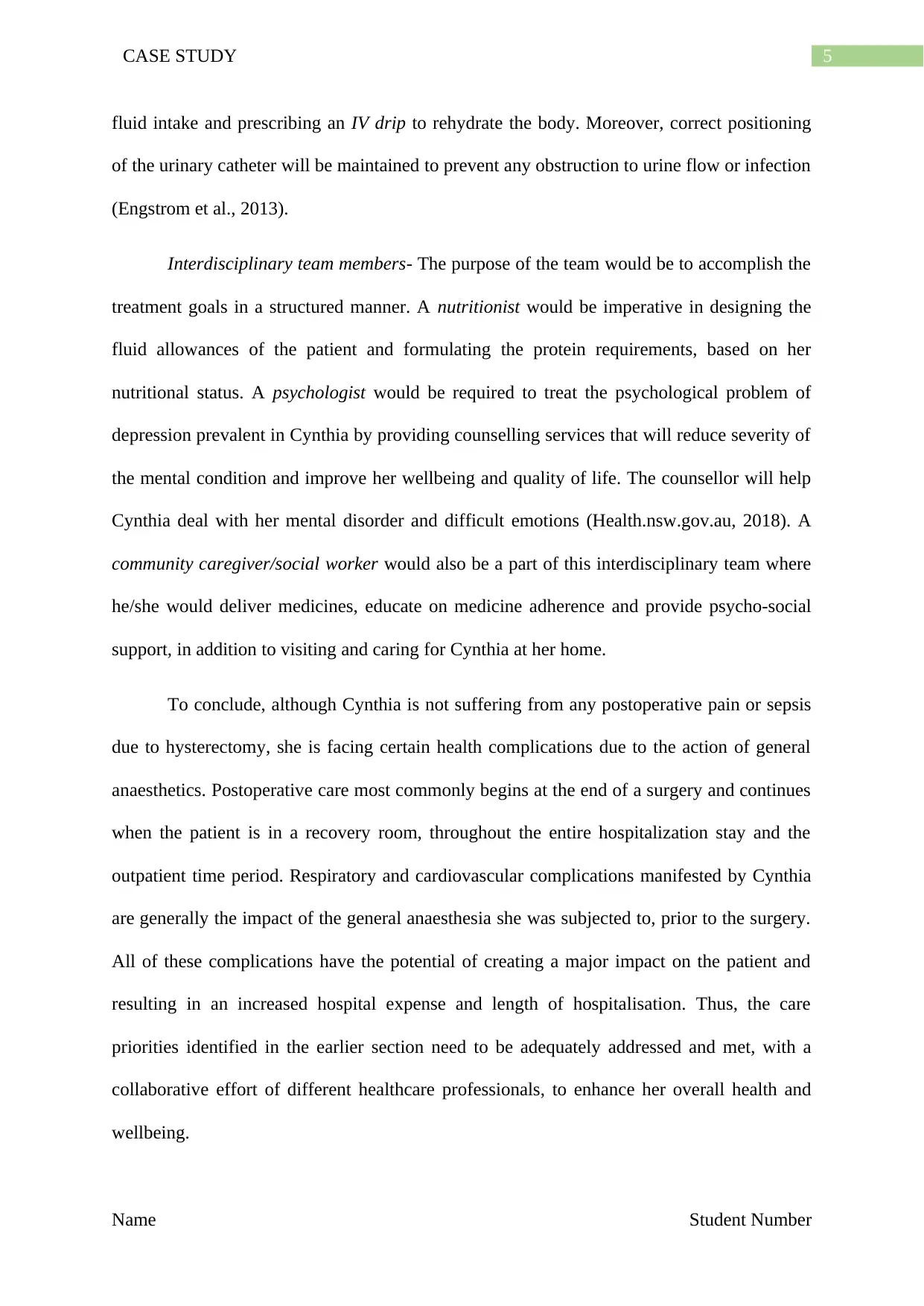
5CASE STUDY
fluid intake and prescribing an IV drip to rehydrate the body. Moreover, correct positioning
of the urinary catheter will be maintained to prevent any obstruction to urine flow or infection
(Engstrom et al., 2013).
Interdisciplinary team members- The purpose of the team would be to accomplish the
treatment goals in a structured manner. A nutritionist would be imperative in designing the
fluid allowances of the patient and formulating the protein requirements, based on her
nutritional status. A psychologist would be required to treat the psychological problem of
depression prevalent in Cynthia by providing counselling services that will reduce severity of
the mental condition and improve her wellbeing and quality of life. The counsellor will help
Cynthia deal with her mental disorder and difficult emotions (Health.nsw.gov.au, 2018). A
community caregiver/social worker would also be a part of this interdisciplinary team where
he/she would deliver medicines, educate on medicine adherence and provide psycho-social
support, in addition to visiting and caring for Cynthia at her home.
To conclude, although Cynthia is not suffering from any postoperative pain or sepsis
due to hysterectomy, she is facing certain health complications due to the action of general
anaesthetics. Postoperative care most commonly begins at the end of a surgery and continues
when the patient is in a recovery room, throughout the entire hospitalization stay and the
outpatient time period. Respiratory and cardiovascular complications manifested by Cynthia
are generally the impact of the general anaesthesia she was subjected to, prior to the surgery.
All of these complications have the potential of creating a major impact on the patient and
resulting in an increased hospital expense and length of hospitalisation. Thus, the care
priorities identified in the earlier section need to be adequately addressed and met, with a
collaborative effort of different healthcare professionals, to enhance her overall health and
wellbeing.
Name Student Number
fluid intake and prescribing an IV drip to rehydrate the body. Moreover, correct positioning
of the urinary catheter will be maintained to prevent any obstruction to urine flow or infection
(Engstrom et al., 2013).
Interdisciplinary team members- The purpose of the team would be to accomplish the
treatment goals in a structured manner. A nutritionist would be imperative in designing the
fluid allowances of the patient and formulating the protein requirements, based on her
nutritional status. A psychologist would be required to treat the psychological problem of
depression prevalent in Cynthia by providing counselling services that will reduce severity of
the mental condition and improve her wellbeing and quality of life. The counsellor will help
Cynthia deal with her mental disorder and difficult emotions (Health.nsw.gov.au, 2018). A
community caregiver/social worker would also be a part of this interdisciplinary team where
he/she would deliver medicines, educate on medicine adherence and provide psycho-social
support, in addition to visiting and caring for Cynthia at her home.
To conclude, although Cynthia is not suffering from any postoperative pain or sepsis
due to hysterectomy, she is facing certain health complications due to the action of general
anaesthetics. Postoperative care most commonly begins at the end of a surgery and continues
when the patient is in a recovery room, throughout the entire hospitalization stay and the
outpatient time period. Respiratory and cardiovascular complications manifested by Cynthia
are generally the impact of the general anaesthesia she was subjected to, prior to the surgery.
All of these complications have the potential of creating a major impact on the patient and
resulting in an increased hospital expense and length of hospitalisation. Thus, the care
priorities identified in the earlier section need to be adequately addressed and met, with a
collaborative effort of different healthcare professionals, to enhance her overall health and
wellbeing.
Name Student Number

6CASE STUDY
Name Student Number
Name Student Number
Paraphrase This Document
Need a fresh take? Get an instant paraphrase of this document with our AI Paraphraser
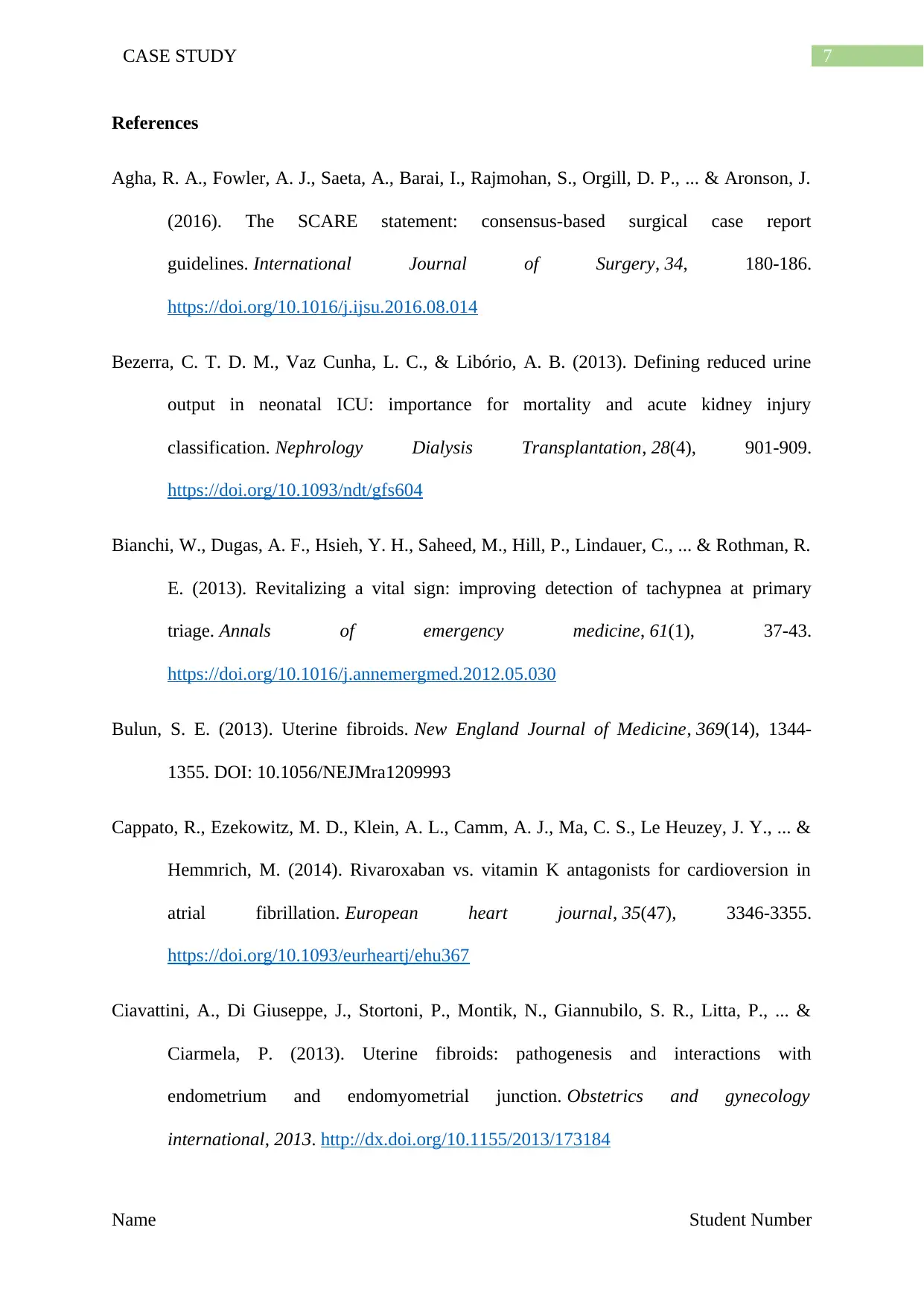
7CASE STUDY
References
Agha, R. A., Fowler, A. J., Saeta, A., Barai, I., Rajmohan, S., Orgill, D. P., ... & Aronson, J.
(2016). The SCARE statement: consensus-based surgical case report
guidelines. International Journal of Surgery, 34, 180-186.
https://doi.org/10.1016/j.ijsu.2016.08.014
Bezerra, C. T. D. M., Vaz Cunha, L. C., & Libório, A. B. (2013). Defining reduced urine
output in neonatal ICU: importance for mortality and acute kidney injury
classification. Nephrology Dialysis Transplantation, 28(4), 901-909.
https://doi.org/10.1093/ndt/gfs604
Bianchi, W., Dugas, A. F., Hsieh, Y. H., Saheed, M., Hill, P., Lindauer, C., ... & Rothman, R.
E. (2013). Revitalizing a vital sign: improving detection of tachypnea at primary
triage. Annals of emergency medicine, 61(1), 37-43.
https://doi.org/10.1016/j.annemergmed.2012.05.030
Bulun, S. E. (2013). Uterine fibroids. New England Journal of Medicine, 369(14), 1344-
1355. DOI: 10.1056/NEJMra1209993
Cappato, R., Ezekowitz, M. D., Klein, A. L., Camm, A. J., Ma, C. S., Le Heuzey, J. Y., ... &
Hemmrich, M. (2014). Rivaroxaban vs. vitamin K antagonists for cardioversion in
atrial fibrillation. European heart journal, 35(47), 3346-3355.
https://doi.org/10.1093/eurheartj/ehu367
Ciavattini, A., Di Giuseppe, J., Stortoni, P., Montik, N., Giannubilo, S. R., Litta, P., ... &
Ciarmela, P. (2013). Uterine fibroids: pathogenesis and interactions with
endometrium and endomyometrial junction. Obstetrics and gynecology
international, 2013. http://dx.doi.org/10.1155/2013/173184
Name Student Number
References
Agha, R. A., Fowler, A. J., Saeta, A., Barai, I., Rajmohan, S., Orgill, D. P., ... & Aronson, J.
(2016). The SCARE statement: consensus-based surgical case report
guidelines. International Journal of Surgery, 34, 180-186.
https://doi.org/10.1016/j.ijsu.2016.08.014
Bezerra, C. T. D. M., Vaz Cunha, L. C., & Libório, A. B. (2013). Defining reduced urine
output in neonatal ICU: importance for mortality and acute kidney injury
classification. Nephrology Dialysis Transplantation, 28(4), 901-909.
https://doi.org/10.1093/ndt/gfs604
Bianchi, W., Dugas, A. F., Hsieh, Y. H., Saheed, M., Hill, P., Lindauer, C., ... & Rothman, R.
E. (2013). Revitalizing a vital sign: improving detection of tachypnea at primary
triage. Annals of emergency medicine, 61(1), 37-43.
https://doi.org/10.1016/j.annemergmed.2012.05.030
Bulun, S. E. (2013). Uterine fibroids. New England Journal of Medicine, 369(14), 1344-
1355. DOI: 10.1056/NEJMra1209993
Cappato, R., Ezekowitz, M. D., Klein, A. L., Camm, A. J., Ma, C. S., Le Heuzey, J. Y., ... &
Hemmrich, M. (2014). Rivaroxaban vs. vitamin K antagonists for cardioversion in
atrial fibrillation. European heart journal, 35(47), 3346-3355.
https://doi.org/10.1093/eurheartj/ehu367
Ciavattini, A., Di Giuseppe, J., Stortoni, P., Montik, N., Giannubilo, S. R., Litta, P., ... &
Ciarmela, P. (2013). Uterine fibroids: pathogenesis and interactions with
endometrium and endomyometrial junction. Obstetrics and gynecology
international, 2013. http://dx.doi.org/10.1155/2013/173184
Name Student Number
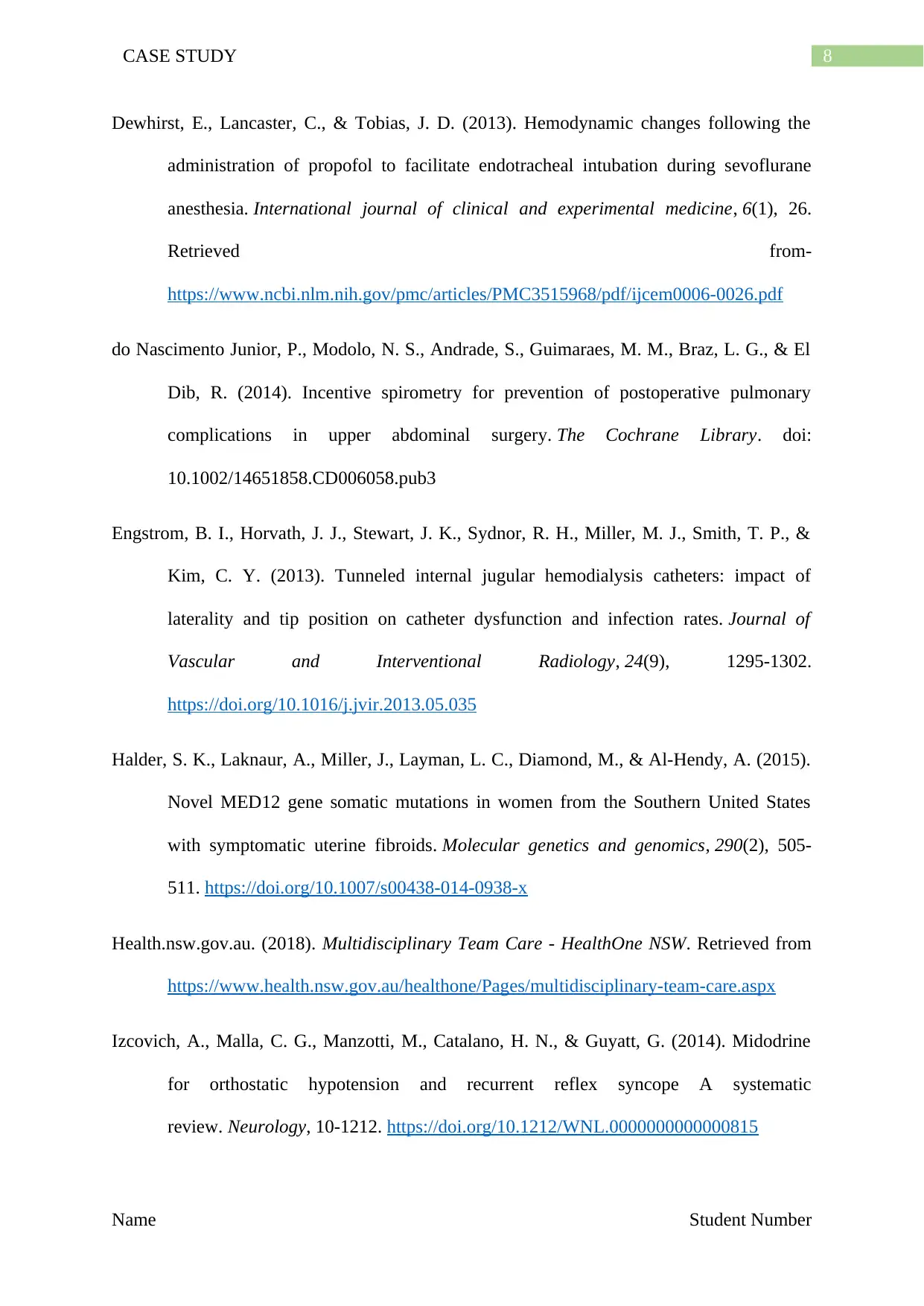
8CASE STUDY
Dewhirst, E., Lancaster, C., & Tobias, J. D. (2013). Hemodynamic changes following the
administration of propofol to facilitate endotracheal intubation during sevoflurane
anesthesia. International journal of clinical and experimental medicine, 6(1), 26.
Retrieved from-
https://www.ncbi.nlm.nih.gov/pmc/articles/PMC3515968/pdf/ijcem0006-0026.pdf
do Nascimento Junior, P., Modolo, N. S., Andrade, S., Guimaraes, M. M., Braz, L. G., & El
Dib, R. (2014). Incentive spirometry for prevention of postoperative pulmonary
complications in upper abdominal surgery. The Cochrane Library. doi:
10.1002/14651858.CD006058.pub3
Engstrom, B. I., Horvath, J. J., Stewart, J. K., Sydnor, R. H., Miller, M. J., Smith, T. P., &
Kim, C. Y. (2013). Tunneled internal jugular hemodialysis catheters: impact of
laterality and tip position on catheter dysfunction and infection rates. Journal of
Vascular and Interventional Radiology, 24(9), 1295-1302.
https://doi.org/10.1016/j.jvir.2013.05.035
Halder, S. K., Laknaur, A., Miller, J., Layman, L. C., Diamond, M., & Al-Hendy, A. (2015).
Novel MED12 gene somatic mutations in women from the Southern United States
with symptomatic uterine fibroids. Molecular genetics and genomics, 290(2), 505-
511. https://doi.org/10.1007/s00438-014-0938-x
Health.nsw.gov.au. (2018). Multidisciplinary Team Care - HealthOne NSW. Retrieved from
https://www.health.nsw.gov.au/healthone/Pages/multidisciplinary-team-care.aspx
Izcovich, A., Malla, C. G., Manzotti, M., Catalano, H. N., & Guyatt, G. (2014). Midodrine
for orthostatic hypotension and recurrent reflex syncope A systematic
review. Neurology, 10-1212. https://doi.org/10.1212/WNL.0000000000000815
Name Student Number
Dewhirst, E., Lancaster, C., & Tobias, J. D. (2013). Hemodynamic changes following the
administration of propofol to facilitate endotracheal intubation during sevoflurane
anesthesia. International journal of clinical and experimental medicine, 6(1), 26.
Retrieved from-
https://www.ncbi.nlm.nih.gov/pmc/articles/PMC3515968/pdf/ijcem0006-0026.pdf
do Nascimento Junior, P., Modolo, N. S., Andrade, S., Guimaraes, M. M., Braz, L. G., & El
Dib, R. (2014). Incentive spirometry for prevention of postoperative pulmonary
complications in upper abdominal surgery. The Cochrane Library. doi:
10.1002/14651858.CD006058.pub3
Engstrom, B. I., Horvath, J. J., Stewart, J. K., Sydnor, R. H., Miller, M. J., Smith, T. P., &
Kim, C. Y. (2013). Tunneled internal jugular hemodialysis catheters: impact of
laterality and tip position on catheter dysfunction and infection rates. Journal of
Vascular and Interventional Radiology, 24(9), 1295-1302.
https://doi.org/10.1016/j.jvir.2013.05.035
Halder, S. K., Laknaur, A., Miller, J., Layman, L. C., Diamond, M., & Al-Hendy, A. (2015).
Novel MED12 gene somatic mutations in women from the Southern United States
with symptomatic uterine fibroids. Molecular genetics and genomics, 290(2), 505-
511. https://doi.org/10.1007/s00438-014-0938-x
Health.nsw.gov.au. (2018). Multidisciplinary Team Care - HealthOne NSW. Retrieved from
https://www.health.nsw.gov.au/healthone/Pages/multidisciplinary-team-care.aspx
Izcovich, A., Malla, C. G., Manzotti, M., Catalano, H. N., & Guyatt, G. (2014). Midodrine
for orthostatic hypotension and recurrent reflex syncope A systematic
review. Neurology, 10-1212. https://doi.org/10.1212/WNL.0000000000000815
Name Student Number
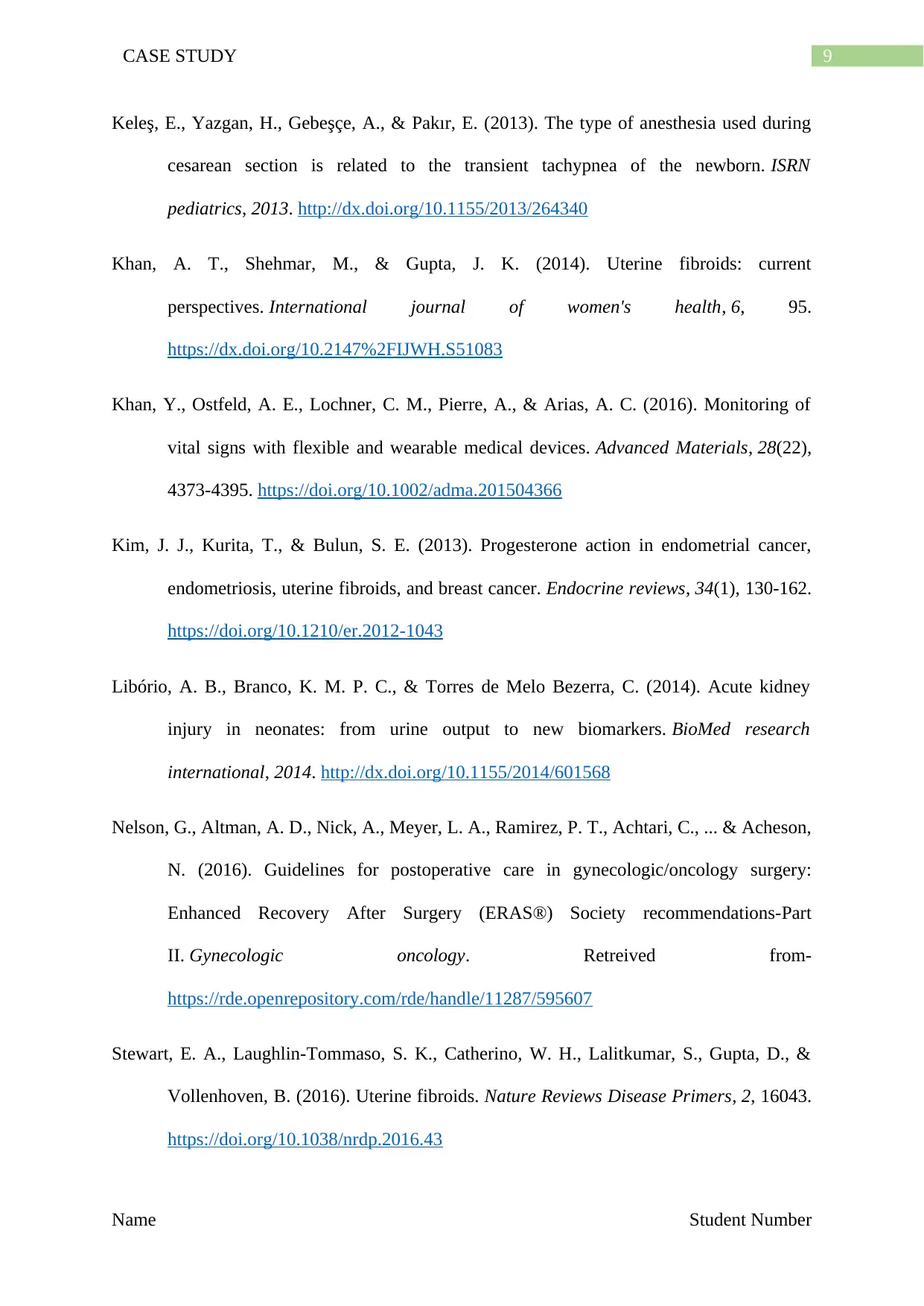
9CASE STUDY
Keleş, E., Yazgan, H., Gebeşçe, A., & Pakır, E. (2013). The type of anesthesia used during
cesarean section is related to the transient tachypnea of the newborn. ISRN
pediatrics, 2013. http://dx.doi.org/10.1155/2013/264340
Khan, A. T., Shehmar, M., & Gupta, J. K. (2014). Uterine fibroids: current
perspectives. International journal of women's health, 6, 95.
https://dx.doi.org/10.2147%2FIJWH.S51083
Khan, Y., Ostfeld, A. E., Lochner, C. M., Pierre, A., & Arias, A. C. (2016). Monitoring of
vital signs with flexible and wearable medical devices. Advanced Materials, 28(22),
4373-4395. https://doi.org/10.1002/adma.201504366
Kim, J. J., Kurita, T., & Bulun, S. E. (2013). Progesterone action in endometrial cancer,
endometriosis, uterine fibroids, and breast cancer. Endocrine reviews, 34(1), 130-162.
https://doi.org/10.1210/er.2012-1043
Libório, A. B., Branco, K. M. P. C., & Torres de Melo Bezerra, C. (2014). Acute kidney
injury in neonates: from urine output to new biomarkers. BioMed research
international, 2014. http://dx.doi.org/10.1155/2014/601568
Nelson, G., Altman, A. D., Nick, A., Meyer, L. A., Ramirez, P. T., Achtari, C., ... & Acheson,
N. (2016). Guidelines for postoperative care in gynecologic/oncology surgery:
Enhanced Recovery After Surgery (ERAS®) Society recommendations-Part
II. Gynecologic oncology. Retreived from-
https://rde.openrepository.com/rde/handle/11287/595607
Stewart, E. A., Laughlin-Tommaso, S. K., Catherino, W. H., Lalitkumar, S., Gupta, D., &
Vollenhoven, B. (2016). Uterine fibroids. Nature Reviews Disease Primers, 2, 16043.
https://doi.org/10.1038/nrdp.2016.43
Name Student Number
Keleş, E., Yazgan, H., Gebeşçe, A., & Pakır, E. (2013). The type of anesthesia used during
cesarean section is related to the transient tachypnea of the newborn. ISRN
pediatrics, 2013. http://dx.doi.org/10.1155/2013/264340
Khan, A. T., Shehmar, M., & Gupta, J. K. (2014). Uterine fibroids: current
perspectives. International journal of women's health, 6, 95.
https://dx.doi.org/10.2147%2FIJWH.S51083
Khan, Y., Ostfeld, A. E., Lochner, C. M., Pierre, A., & Arias, A. C. (2016). Monitoring of
vital signs with flexible and wearable medical devices. Advanced Materials, 28(22),
4373-4395. https://doi.org/10.1002/adma.201504366
Kim, J. J., Kurita, T., & Bulun, S. E. (2013). Progesterone action in endometrial cancer,
endometriosis, uterine fibroids, and breast cancer. Endocrine reviews, 34(1), 130-162.
https://doi.org/10.1210/er.2012-1043
Libório, A. B., Branco, K. M. P. C., & Torres de Melo Bezerra, C. (2014). Acute kidney
injury in neonates: from urine output to new biomarkers. BioMed research
international, 2014. http://dx.doi.org/10.1155/2014/601568
Nelson, G., Altman, A. D., Nick, A., Meyer, L. A., Ramirez, P. T., Achtari, C., ... & Acheson,
N. (2016). Guidelines for postoperative care in gynecologic/oncology surgery:
Enhanced Recovery After Surgery (ERAS®) Society recommendations-Part
II. Gynecologic oncology. Retreived from-
https://rde.openrepository.com/rde/handle/11287/595607
Stewart, E. A., Laughlin-Tommaso, S. K., Catherino, W. H., Lalitkumar, S., Gupta, D., &
Vollenhoven, B. (2016). Uterine fibroids. Nature Reviews Disease Primers, 2, 16043.
https://doi.org/10.1038/nrdp.2016.43
Name Student Number
Secure Best Marks with AI Grader
Need help grading? Try our AI Grader for instant feedback on your assignments.
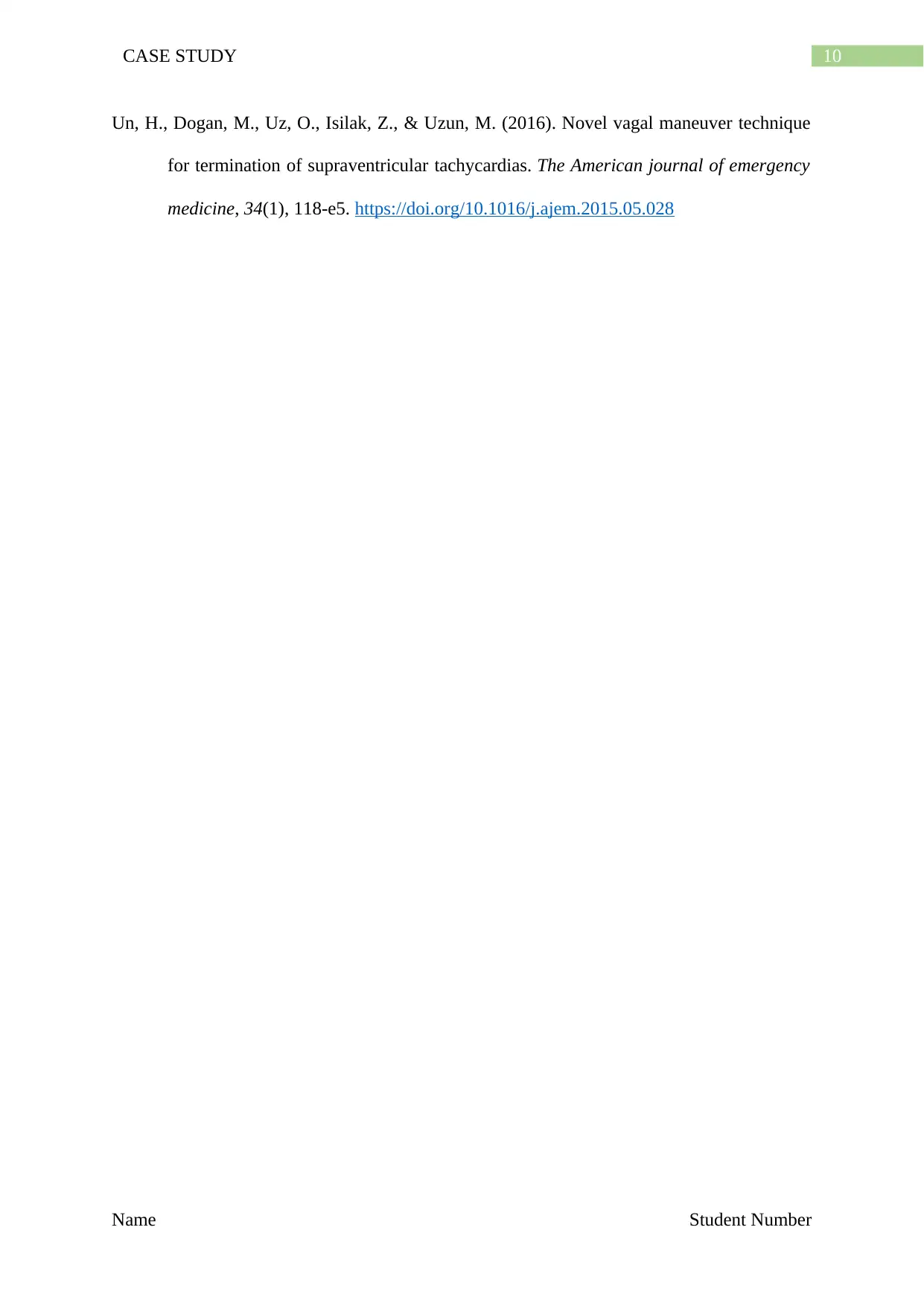
10CASE STUDY
Un, H., Dogan, M., Uz, O., Isilak, Z., & Uzun, M. (2016). Novel vagal maneuver technique
for termination of supraventricular tachycardias. The American journal of emergency
medicine, 34(1), 118-e5. https://doi.org/10.1016/j.ajem.2015.05.028
Name Student Number
Un, H., Dogan, M., Uz, O., Isilak, Z., & Uzun, M. (2016). Novel vagal maneuver technique
for termination of supraventricular tachycardias. The American journal of emergency
medicine, 34(1), 118-e5. https://doi.org/10.1016/j.ajem.2015.05.028
Name Student Number
1 out of 11
Related Documents
Your All-in-One AI-Powered Toolkit for Academic Success.
+13062052269
info@desklib.com
Available 24*7 on WhatsApp / Email
![[object Object]](/_next/static/media/star-bottom.7253800d.svg)
Unlock your academic potential
© 2024 | Zucol Services PVT LTD | All rights reserved.





